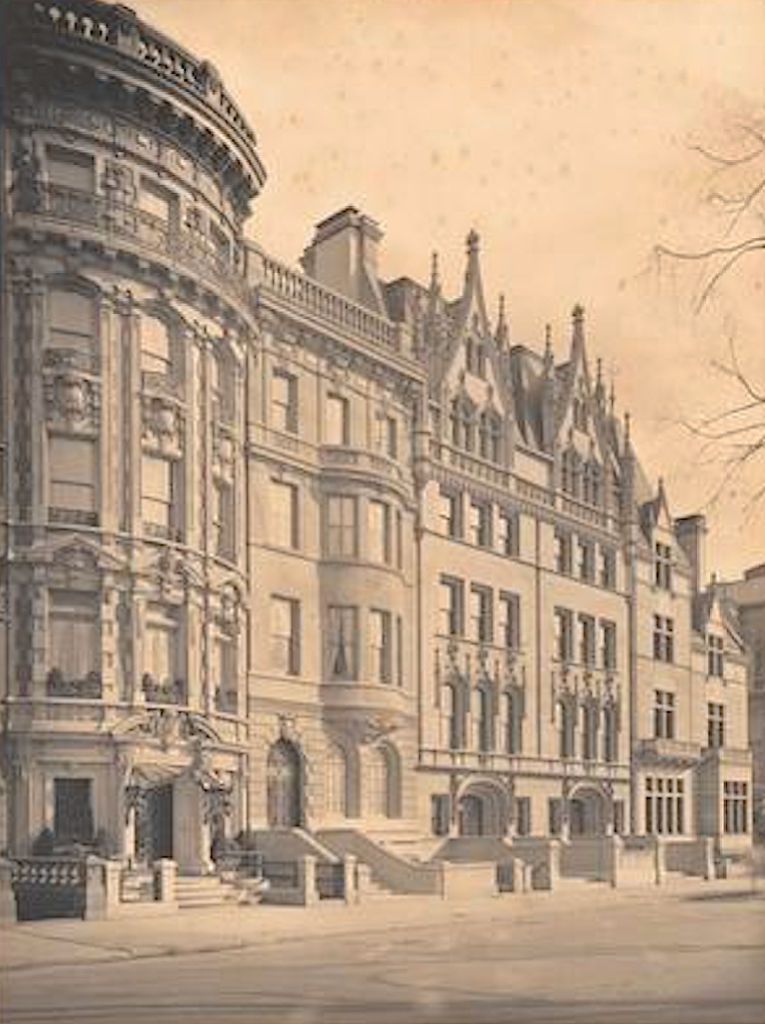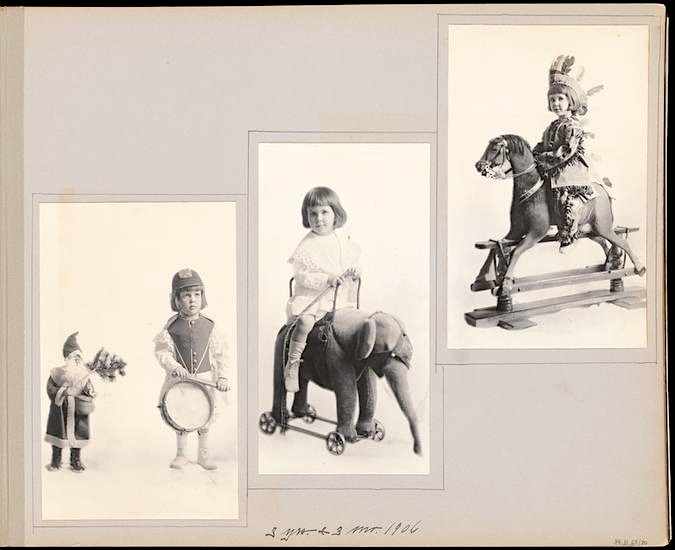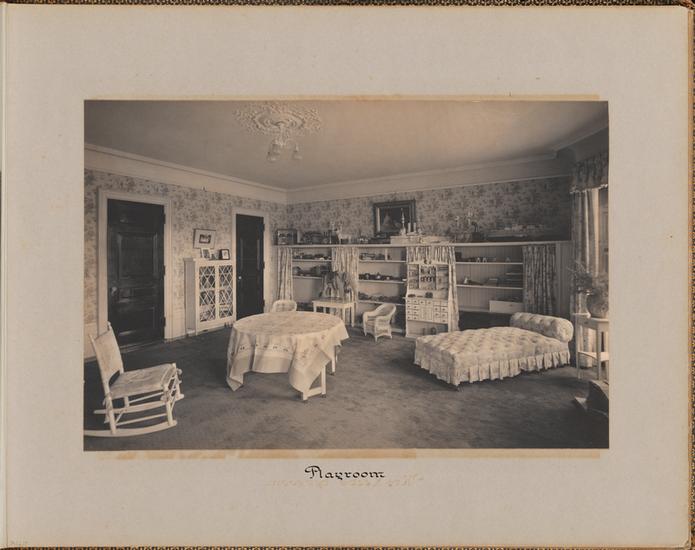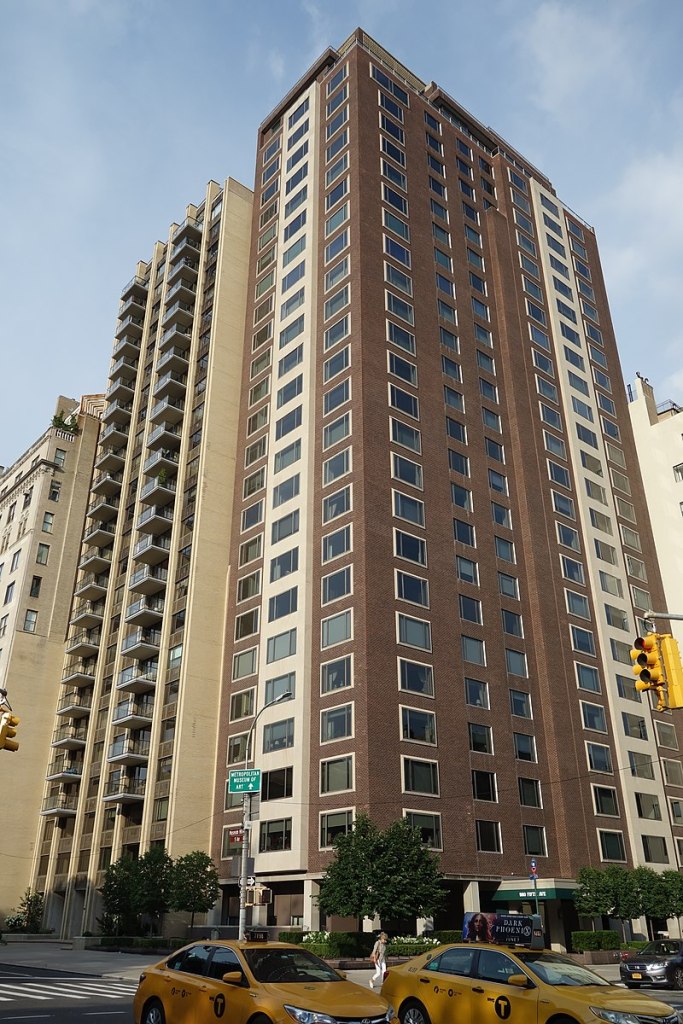In 1901, a five-story, brick and limestone Beaux-Arts townhouse (below, far left) made its debut on Fifth Avenue between 79th and 80th Streets.
Described by one newspaper as “one of the finest houses on Upper Fifth Avenue,” this stylish piece of real estate wasn’t the most ostentatious mansion in the neighborhood.
But with its bow front, numerous ornamental carvings, and iron balcony wrapping around the fifth floor, it had an excess of Gilded Age architectural bells and whistles compared to its more restrained and balanced neighbors.
The owner, William Bateman Leeds, was a tremendously wealthy businessman. Born in Indiana, Leeds didn’t come from money. But this enterprising former railroad engineer founded a company that produced tin. After monopolizing the tin industry and eventually selling his company to U.S. Steel, Leeds earned the nickname the “Tin Plate King.”
At the turn of the 20th century, the Tin Plate King reportedly paid his first wife a million dollars for a divorce. After his marriage was dissolved he wed his second wife, Nonnie May “Nancy” Stewart, in 1901.
The Fifth Avenue house, which he bought for $260,000 and paid another $70,000 to add a marble hall and staircase, was a gift for his beloved bride.
The couple’s incredible wealth made them regulars on the society pages of New York newspapers. But it was their baby son, William Bateman Leeds, Jr., who arguably became the mansion’s most famous resident.
Dubbed the “world’s richest boy,” young William Leeds was born on September 19, 1902. From his earliest years, he had everything a pampered Gilded Age child could want—lots of toys, play clothes, and an entire playroom in his Fifth Avenue mansion, as these photos show.
But hobby horses and toy trains only go so far. “William’s life, sadly, was not all presents and playing,” wrote Susannah Broyles in a 2014 blog post from the Museum of the City of New York, which has these photos of young William in its collection.
“For some reason, his mother, Nancy, believed her son to be frailer than most and kept him secluded from the outside world for much of his childhood.”
Things drastically changed for the boy in 1908, when his father died at the Hotel Ritz while vacationing in Paris. Though accounts of the amount of money he supposedly inherited varies, William “was now the the proud inheritor of a cool $30,000,000 to $40,000,000 (nearly a billion dollars in today’s money),” states Broyles.
After selling the Fifth Avenue townhouse in 1911, William’s mother moved him to an estate in Montclair, New Jersey. While she relocated to London with the aim of remarrying into royalty, William was left behind “with a governess, housekeeper, and 15 servants to meet his slightest wish,” according to one 1912 newspaper article.
“Mrs. Leeds keeps in touch with the lad almost daily through cable messages and is kept constantly posted as to his physical condition and progress in school,” the article continued.
William joined his mother in England a year later, and she enrolled him at Eton. Nancy, meanwhile, found a Greek prince to marry in 1920 and became known for the rest of her life as Princess Anastasia (above painting, 1922)
By now, William was a young man, and his whereabouts regularly made the gossip pages. While visiting his mother in Greece he fell in love with 17-year-old Princess Xenia, and the two married in 1921 (below).
They eventually divorced, and William tied the knot a second time with a former Atlantic City telephone operator. The two maintained an apartment at 30 Beekman Place and shared a love of travel and yachting.
The world’s richest boy, who spent the first years of his life swaddled in luxury in a Fifth Avenue townhouse, didn’t turn out to be a stereotypical caddish rich kid or win-at-all-costs titan of industry.
As an adult, William kept a low profile and pursued philanthropy, “sending a boatload of medical supplies to Pitcairn Island in the dark days before Pearl Harbor, supporting a leper colony in Tahiti, donating an entire ambulance corps to the British when they were fighting Germany virtually alone,” per his obituary, among other causes.
After a cancer diagnosis, he died in 1972 at age 69 at his home in the Virgin Islands, an apparent suicide.
And what was the fate of his Fifth Avenue childhood home? After changing hands for several decades and being carved up into apartments, the townhouse was sold to a developer in 1959. A decade later, a 25-story glass and brick apartment tower took its place (above photo, middle building) and still stands today.
[Top photo: MCNY, 89.3.2.3; second photo: MCNY, 89.3.1.49; third photo: MCNY, 89.3.2.17; fourth image: MCNY, 89.3.1.41; fifth image: Wikipedia; sixth image: Wikipedia]
Tags: 987 Fifth Avenue townhouse Gilded Age, Fifth Avenue Beaux Arts Townhouse, Gilded Age New York Richest Boy, Gilded Age NYC Fifth Avenue Townhouse, William B. Leeds, William B. Leeds Jr. World's Richest Boy NYC, World's Richest Boy Gilded Age NYC








June 17, 2024 at 7:25 am |
who was the architect of the 5th Avenue mansion?
June 17, 2024 at 3:23 pm |
According to the Metropolitan Museum Historic District Report, it was the firm of Welch, Smith & Provot. Alexander McMillan Welch dia several Beaux-Arts style buildings in New York at the time.
June 18, 2024 at 9:40 am |
His mother died of cancer just three years after she married her prince. Not a very happy life for anyone in this family, I think. https://www.findagrave.com/memorial/61474862/anastasia-nonnie_may-oldenburg
Here’s Leeds’ NYTimes obit: https://www.nytimes.com/1972/01/03/archives/william-b-leeds-sportsman-dead-heir-to-tinplate-fortune-donated-to.html
June 18, 2024 at 4:35 pm |
Did the Leeds mansion go down with the Brokaw mansion?
June 18, 2024 at 11:28 pm |
Hi Carla, I believe it did. According to the historic district report, number 987 went down with 986 and 985. Number 985, home of a Brokaw son, was the last of the Brokaw mansions to be demolished.
June 19, 2024 at 1:31 pm
Anthony Campagna strikes again!
June 19, 2024 at 2:01 pm |
That family sounds a bit like the Kennedys–so wealthy, yet so tragic.
In a weird way, the jagged front of the current apartment building echoes the front of the mansion.